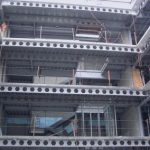How Cellular and Castellated Beams Can Boost Composite Construction
In the midst of a major construction project? Or are you exploring options as you prepare for a major new undertaking? No matter what stage of the project you’re on, there are several key factors you’ll be focusing on including saving time, saving money, and increasing the overall security and stability of your architecture.
As it turns out, composite construction may be able to offer you all of these benefits and many more. Despite this, however, many entrepreneurs and businesses do not fully understand what composite construction is and how it can benefit them.
Curious how it can benefit you? Keep reading to discover our comprehensive guide to everything you need to know about composite construction!
What Is Composite Construction?
We’ve prepared a comprehensive guide to how cellular and castellated beams can be your secret weapon when it comes to composite construction. Before we go further, though, it’s important to answer a simple question: what is composite construction?
The term “composite construction” describes two structural members that are connected and function as one. These two structural members are often made of different materials, but the finished product acts as one unit. Over the years, it has become the preferred standard among engineers, architects, and other construction developers. This is because it offers a number of distinct advantages.
Curious if composite construction is the best choice for your project and how these beams can help? Keep reading to learn about the many advantages this construction choice offers you and your business.
What Are the Advantages of Composite Construction?
One of the chief advantages of composite construction is that it is strong and light at the same time. This means that you can save a lot of time on any given project without having to sacrifice the stability and security of your newest projects. Also, by reducing the weight of a structural frame, you may be able to reduce foundation costs.
At the same time, composite construction is less expensive than more traditional forms of construction. This allows you to either save money outright on your structure or use the money that you saved to invest in additional features for your upcoming space.
And because of the very solid reputation of composite construction, everyone from investors to future customers will breathe easier when they walk inside your building. In this way, you can build your brand while still saving time and money.
Another advantage of composite construction is their spans can vary (we’ll get into more details on this later). This can make construction easier while also helping create structures of all sizes in a short amount of time.
Are There Any Disadvantages?
We have focused extensively on the advantages of composite construction. That’s easy to do simply because there are so many advantages. However, this leads to a pretty natural question: are there any possible disadvantages?
The answer? It depends. If neither you nor your team has ever worked with composite construction before, you may need to hire additional field contractors to make sure everything goes smoothly.
On a related note, you may need to hire contractors who have extensive experience with elevated construction. Composite construction offers a lot of design versatility, but you may need to hire a specialist to get the most out of everything.
Additionally, adding composite elements to an existing project may require making additional changes to your schedule. Ultimately, though, we feel that these disadvantages are very minor and pale in comparison to the advantages offered by composite construction.
Why Use Cellular and Castellated Beams for Composite Construction?
Earlier, we focused on the distinct advantages (and a few of the disadvantages) of composite construction. However, the question remains: what role do cellular and castellated beams play, and why are they uniquely suited for the role of composite construction materials?
First, these beams work well for asymmetric design. The sturdy material and long spans make for a great base for the concrete slab that is typically used for composite construction.
These beams also allow to essentially assemble slabs in place through a curing process instead of trying to cast them in place. This is another way that this form of construction can shave significant amounts of time from your project schedule.
The long spans of castellated beams are also optimized for controlled vibration applications. Along with the ability to balance strength and weight, that makes these beams a highly versatile solution to any construction complexities you are facing.
Ultimately, using castellated or cellular beams in your next construction project means taking all of the advantages of composite construction to the next level. They also provide unique opportunities to save time and money without sacrificing the stability or aesthetics of your next structure.
Conclusion
Now you know about the many benefits of composite construction. Additionally, you’ve learned about how castellated beams and cellular beams can be a major benefit to any construction undertaking.
But do you know what step to take next? Here at C-Beams, we are proud to offer a full selection of the castellated and cellular beams that you may need, and with these in hand, you’ll have access to all of the versatility that composite construction has to offer.
So what are you waiting for? There’s no time like the present to completely revolutionize your composite construction dreams!






